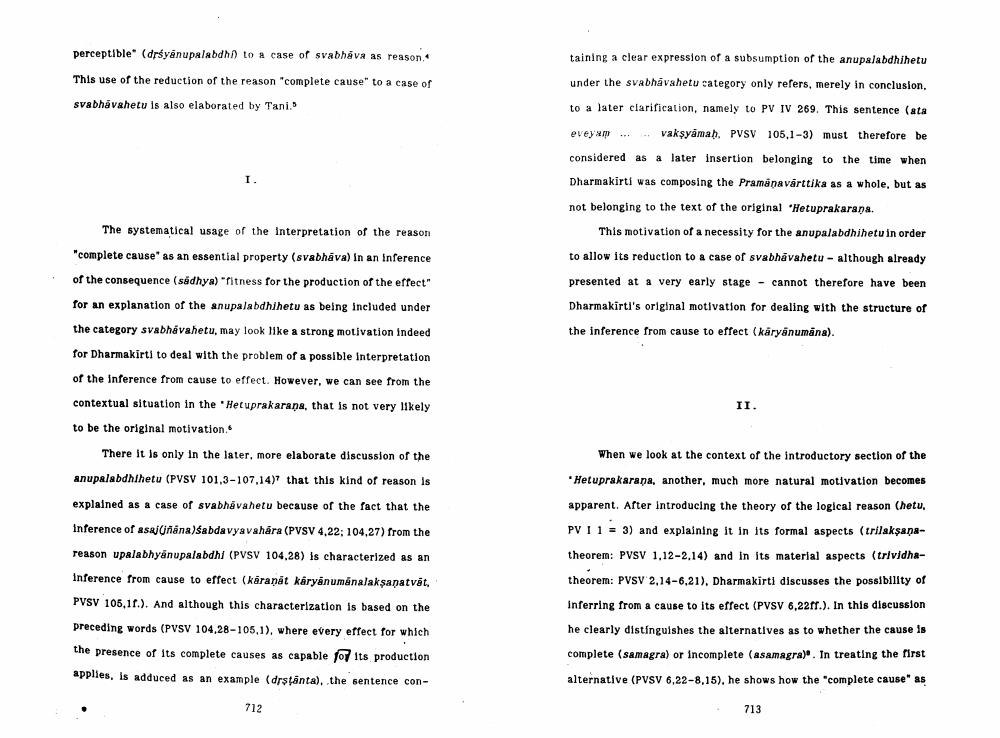Book Title: Dharmakirti On Inference Of Effect Author(s): Ernat Steinkellner Publisher: Ernat Steinkellner View full book textPage 2
________________ perceptible" (drsyanupalabdh to a case of svabhÁVR as reason, taining a clear expression of a subsumption of the anupalabdhihetu This use of the reduction of the reason "complete cause to a case or under the sabhavahetu category only refers, merely in conclusion, to a later clarification, namely to PV IV 269. This sentence (ata svabhavahetu is also elaborated by Tani." eveyam.... vaksyāmah. PVSV 105,1-3) must therefore be considered as a later Insertion belonging to the time when Dharmakirti was composing the Pramana varttika as a whole, but as not belonging to the text of the original 'Hetuprakarana. The systematical usage of the interpretation of the reason This motivation of a necessity for the anupalabdhihetu in order "complete cause as an essential property (svabhava) in an Inference to allow its reduction to a case of svabhavahetu - although already of the consequence (sádhya) fitness for the production of the effect" presented at a very early stage - cannot therefore have been for an explanation of the anupalabdhihetu as being included under Dharmakirti's original motivation for dealing with the structure of the category svabhavahetu, may look like a strong motivation indeed the inference from cause to effect (karyanumana). for Dharmakirti to deal with the problem of a possible interpretation of the Inference from cause to effect. However, we can see from the contextual situation in the "Het uprakarana, that is not very likely to be the original motivation II. There it is only in the later, more elaborate discussion of the anupalabdhihetu (PVSV 101,3-107.14) that this kind of reason is explained as a case of svabhāvahetu because of the fact that the Inference of asaj nána)śabdavyavahára (PVSV 4,22; 104,27) from the reason upalabhyanupalabdhi (PVSV 104.28) is characterized as an Inference from cause to effect (karanát káryánumánalaksanatvát. PVSV 105,17.). And although this characterization is based on the preceding words (PVSV 104.28-105,1), where every effect for which the presence of its complete causes as capable for its production applies, is adduced as an example (drstanta), the sentence con When we look at the context of the introductory section of the Hetuprakarana, another, much more natural motivation becomes apparent. After introducing the theory of the logical reason Chetu, PV I 1 - 3) and explaining it in its formal aspects (trilaksanatheorem: PVSV 1,12-2.14) and in its material aspects (trividhatheorem: PVSV 2,14-6,21), Dharmakirti discusses the possibility of Inferring from a cause to its effect (PVSV 6,2277.). In this discussion he clearly distinguishes the alternatives as to whether the cause is complete (samagra) or incomplete (asamagra)". In treating the first alternative (PVSV 6,22-8.15), he shows how the "complete cause" as 712 713Page Navigation
1 2 3 4 5 6 7 8 9 10 11 12 13 14
